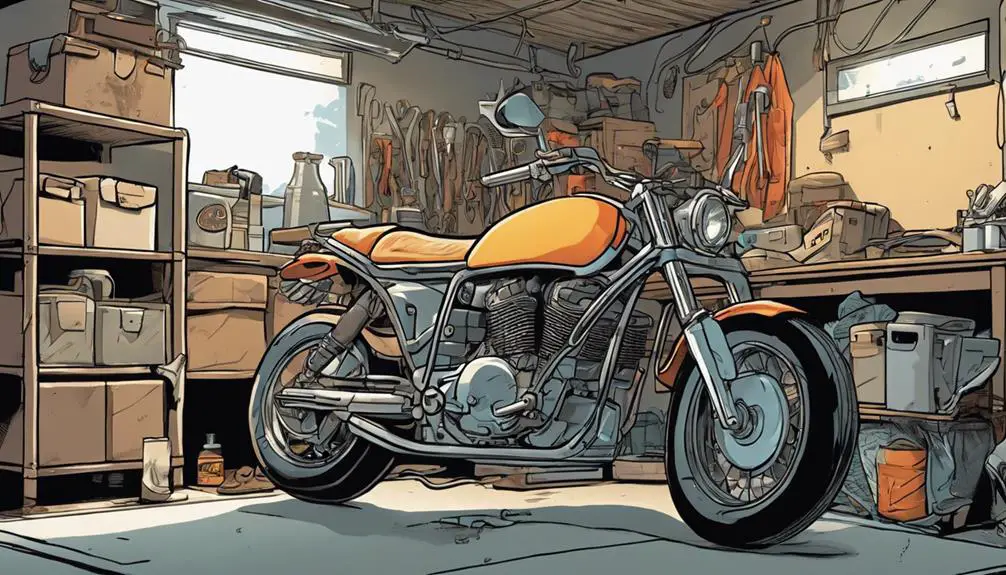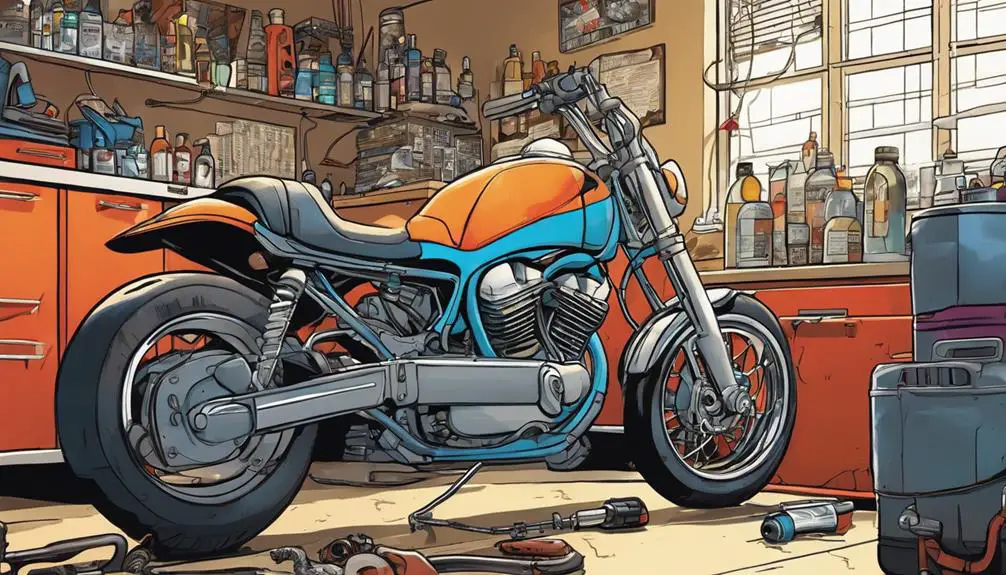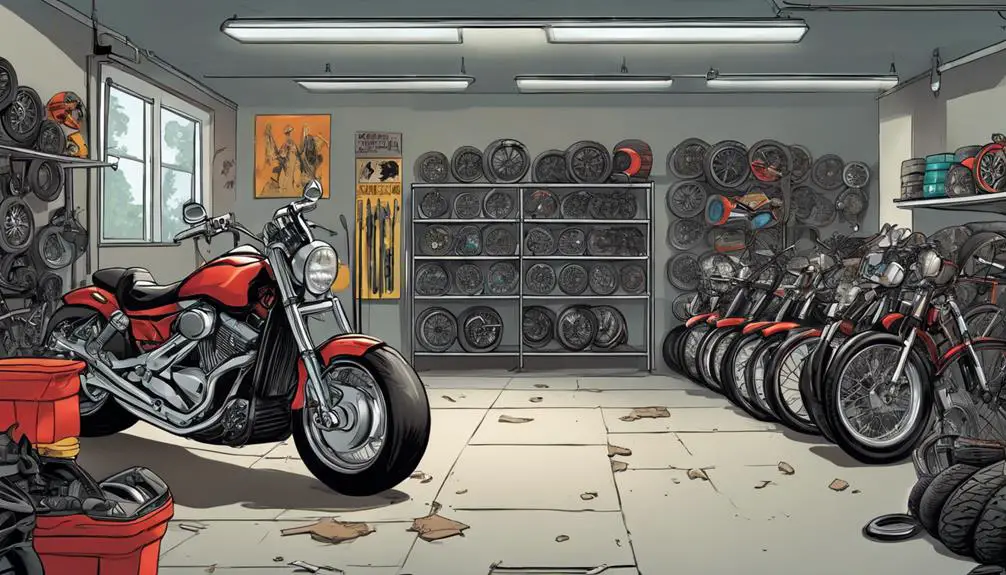You might not realize that improper motorcycle storage can lead to costly repairs and a shorter lifespan for your bike. To avoid these pitfalls, understanding the best practices for storing your motorcycle is essential. It's not just about tucking it away; there are specific steps you should take to guarantee it's protected from environmental damage and mechanical issues. You may be surprised by how simple actions can make a significant difference in your bike's condition when you're ready to ride again. Let's explore some important tips that can help you keep your motorcycle in top shape.
Key Takeaways
- Clean the motorcycle thoroughly before storage to prevent long-term damage from trapped dirt and grime.
- Use a fuel stabilizer and fill the tank with fresh fuel to protect the fuel system.
- Maintain the battery by regularly charging it and checking for clean terminals and electrolyte levels.
- Ensure proper tire inflation and consider using wheel covers to prevent flat spots and protect against environmental damage.
Importance of Proper Storage

Proper storage is essential for keeping your motorcycle in top condition and preventing costly damage. When you treat your bike right, you're not just preserving its mechanical integrity; you're also ensuring your freedom on the road remains intact. Think about it: a well-stored motorcycle means fewer repairs and more time enjoying the ride.
Choosing the right environment for your bike is vital. A garage or a dedicated storage space shields it from harsh weather conditions like rain, snow, or extreme sunlight. These elements can wreak havoc on your motorcycle, causing rust, fading paint, and even engine issues. By securing your bike in a protective space, you're embracing the liberation that comes from knowing it's safe.
Additionally, proper storage can deter theft. A motorcycle left out in the open is an easy target for thieves. Investing in a good lock or alarm system can enhance your bike's security, allowing you to ride worry-free.
Embrace the responsibility of proper storage, and you'll reap the rewards of a reliable motorcycle ready to take you wherever you desire. Your freedom awaits—don't let improper storage hold you back.
Cleaning Before Storage
Cleaning your motorcycle thoroughly before storage is essential for preventing dirt and grime from causing long-term damage.
Start by washing your bike with a gentle soap designed for motorcycles. This helps remove road debris and contaminants that can corrode your bike's finish. Use a microfiber cloth to avoid scratching the surface, and don't forget the nooks and crannies where dirt loves to hide.
Once you're done washing, dry your motorcycle completely to prevent any water spots or rust. A leaf blower can be handy for getting water out of hard-to-reach areas, like the engine and under the seat. After drying, apply a coat of wax to protect the paint and give it a brilliant shine.
Next, tackle the chrome parts using a dedicated chrome cleaner to keep them looking new.
Fuel System Care

When it comes to storing your motorcycle, taking care of the fuel system is essential.
You should apply a fuel stabilizer to prevent degradation and follow proper tank cleaning procedures to keep everything running smoothly.
Let's explore how these steps can protect your bike during its downtime.
Fuel Stabilizer Application
Applying a fuel stabilizer before storing your motorcycle guarantees the fuel system stays in ideal condition during hibernation. By doing this, you prevent fuel breakdown and the formation of harmful deposits that could hinder performance when you're ready to ride again.
Start by filling your tank with fresh fuel, then add the recommended amount of stabilizer. Swirl the mixture around to confirm it's evenly distributed. Don't forget to run the engine for about five to ten minutes; this lets the stabilized fuel reach every corner of your fuel system, keeping everything in top shape.
Remember, the type of stabilizer you choose matters. Go for a high-quality product designed specifically for motorcycles. This small investment now can save you headaches later when you're itching to hit the open road.
Lastly, make a note of when you applied the stabilizer and when you'll want to refill or use the bike again. Keeping track confirms you're ready for that first ride, liberated and free, knowing your motorcycle's fuel system is primed and ready to roar back to life.
Tank Cleaning Procedures
A thorough tank cleaning is essential for maintaining your motorcycle's fuel system and ensuring peak performance when you're ready to ride again.
Start by draining any old fuel from the tank; this helps prevent contaminants from clogging your fuel lines. Use a fuel-safe container for disposal.
Next, inspect the tank for rust or debris. If you find any, grab a tank cleaning solution and some small, abrasive materials like BBs or gravel. Shake the tank with the mixture to dislodge any stubborn grime.
Afterward, rinse the tank thoroughly with fresh fuel to wash away the cleaning solution. Don't forget to check and clean the fuel petcock and filter while you're at it.
Battery Maintenance Tips
To guarantee your motorcycle battery remains in top condition, regularly check its charge and clean the terminals to prevent corrosion. A well-maintained battery not only enhances your ride's performance but also guarantees you're ready to hit the open road whenever the spirit calls.
Here are some essential battery maintenance tips:
- Charge Regularly: If you're storing your motorcycle for an extended period, use a smart charger to maintain the battery's charge without overloading it.
- Clean the Terminals: Use a mixture of baking soda and water to scrub away corrosion, and apply petroleum jelly to protect the terminals after cleaning.
- Inspect for Damage: Check for cracks or leaks in the battery casing. A damaged battery can lead to poor performance or even dangerous situations.
- Check Fluid Levels: If your battery isn't maintenance-free, guarantee the electrolyte levels are adequate, and top them off with distilled water when necessary.
Tire and Wheel Protection

When storing your motorcycle, keeping an eye on tire inflation is essential to prevent flat spots.
Using wheel covers not only protects your tires from UV damage but also keeps dirt and debris at bay.
Let's explore how these simple steps can help maintain your bike's wheels in top condition.
Tire Inflation Maintenance
Maintaining proper tire inflation is essential for guaranteeing your motorcycle's safety and performance during storage. When your bike sits for an extended period, tires can lose air pressure, leading to flat spots or even damage. Here's how you can keep your tires in top shape:
- Check Tire Pressure Regularly: Use a reliable gauge to measure the pressure. Aim for the manufacturer's recommended PSI, usually found on the tire sidewall.
- Inflate to Spec: If you notice low pressure, inflate your tires to the recommended levels immediately. Don't over-inflate; it can cause premature wear and reduce handling.
- Rotate the Motorcycle: If possible, periodically move your bike to change the weight distribution on the tires. This can prevent flat spots from forming.
- Store on a Flat Surface: When parking, guarantee your motorcycle is on a flat, stable surface. This helps maintain even pressure on the tires.
Wheel Cover Usage
Using wheel covers is a smart way to protect your tires and rims from dust, moisture, and UV damage while your motorcycle is in storage. These covers act as a barrier, shielding your wheels from the elements that can cause deterioration over time. When you think about it, it's a simple yet effective way to keep your ride in top shape.
You'll want to choose high-quality covers that fit snugly. Look for materials that are durable and weather-resistant, so they can stand up to whatever nature throws your way. Remember, your motorcycle deserves the best, just like you do!
Installing wheel covers is quick and easy. You can slip them on in seconds, ensuring that your tires stay clean and protected. Plus, they help prevent flat spots from developing, keeping your tires ready for your next adventure.
Covering and Environmental Considerations
Covering your motorcycle properly is essential for protecting it from environmental factors like moisture, debris, and UV rays. When you take the time to shield your ride, you're not just preserving its aesthetic appeal but also its performance.
Here are some best practices to contemplate:
- Choose the Right Cover: Opt for a breathable cover that prevents moisture buildup while keeping out dust and dirt. Avoid plastic materials that trap humidity.
- Secure the Cover: Make sure the cover fits snugly over your bike. Loose covers can flap in the wind and cause scratches.
- Clean Before Covering: Always clean your motorcycle before you cover it. Dirt and grime can cause damage over time if trapped underneath the cover.
- Contemplate Indoor vs. Outdoor Storage: If you're storing your bike indoors, a light dust cover will suffice. For outdoor storage, invest in a heavy-duty waterproof cover designed for full protection against the elements.
Frequently Asked Questions
How Long Can I Store My Motorcycle Without Starting It?
You can store your motorcycle for about a month without starting it, but it's best to avoid longer stretches.
After that, you risk battery drain and fuel degradation.
If you're planning to store it longer, consider using a trickle charger for the battery and stabilizer for the fuel.
Keeping your bike in good shape means you'll feel the freedom of the open road whenever you're ready to ride again!
Is Indoor Storage Better Than Outdoor Storage?
Think of your motorcycle as a precious treasure; it deserves a safe haven.
Indoor storage's like wrapping your bike in a cozy blanket, shielding it from harsh elements, pests, and potential damage.
You'll find it's less prone to rust and fading when tucked away indoors.
Outdoor storage may feel liberating, but it leaves your ride vulnerable.
If you want your motorcycle to thrive, choose the indoors for peace of mind and protection.
Can I Store My Motorcycle With a Full Tank?
You can store your motorcycle with a full tank, but it's not ideal.
Fuel can degrade over time, leading to issues when you're ready to ride again.
Instead, consider filling it up with stabilizer mixed in to preserve its quality.
This way, you're keeping your freedom intact while ensuring your bike runs smoothly when you decide to hit the open road again.
Enjoy the ride, but think ahead!
Should I Remove the Battery When Storing?
When you're tucking your bike away for a while, it's like giving it a well-deserved nap.
To keep that sweet ride in top shape, you should definitely consider removing the battery. It helps prevent corrosion and keeps it fresh for the next adventure.
You'll liberate your motorcycle from potential issues, ensuring it wakes up ready to roar.
What Type of Cover Is Best for Motorcycle Storage?
When you're choosing a cover for your motorcycle, opt for one made from breathable, waterproof material.
A fitted cover protects against dust, moisture, and UV rays, ensuring your bike stays in top shape.
Avoid plastic covers, as they can trap moisture and lead to corrosion.
Look for a cover with secure straps to keep it in place during windy conditions.
This way, you can ride freely whenever you're ready to hit the road again!
Conclusion
In summary, taking the time to store your motorcycle properly is essential for its longevity and performance.
Just like a knight preparing for battle, you need to guarantee every detail is attended to—from cleaning to maintaining battery health.
By following these best practices, you'll keep your bike in top shape, ready to hit the road when the time comes.
Remember, a well-cared-for motorcycle isn't just a ride; it's a trusty steed waiting for your next adventure.